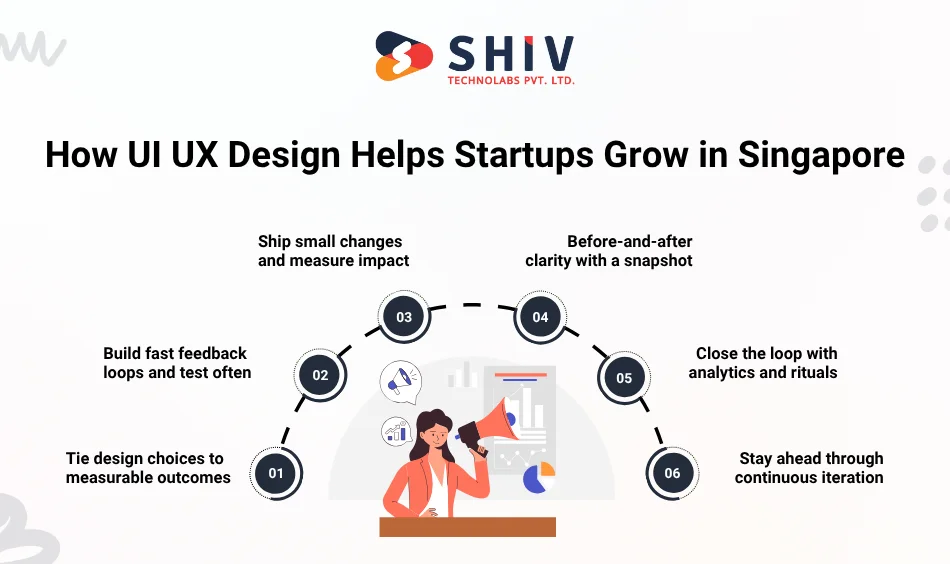Table of Contents
Singapore’s startup scene moves fast, and thoughtful UI/UX separates real value from look-alike apps daily. Partnering with a ui ux design agency in Singapore helps founders build trust and confident first impressions. This article covers UI UX for startups in Singapore and actionable user experience design methods that drive traction today.
Teams juggle tight budgets, bold targets, and users who compare every tap against polished regional competitors. Clear flows cut friction, explain value fast, and guide people through signup, onboarding, checkout, and support journeys. Readable type, consistent patterns, and mobile-first layouts keep visitors active, returning, and ready to convert quickly across repeated sessions.
In a crowded market, credibility matters as much as features, pricing, marketing, and rapid response speed during support. Straightforward writing and honest prompts reduce hesitation significantly at payments, permissions, subscriptions, and other sensitive decisions. Let’s understand how UI/UX shapes startup success in Singapore’s fast-paced market.
Why UI UX Design Is Important for Startups
Founders often ask why UI UX is important for startups when speed and shipping appear most urgent. Great design shortens paths, trims support questions, and helps users finish critical tasks on the first try. Those wins drive early traction while protecting budgets and timelines during hectic launch cycles and pivots.
Usability sits at the core of UI UX design for startups because it turns intention into clear action. Short, logical flows reduce confusion, and visual hierarchy highlights the primary action at every decision point. Plain microcopy answers objections early, guiding permissions, payments, and subscriptions without pressure or hidden surprises.
A Singapore fintech wallet cut onboarding from seven scattered steps to three guided screens with progress indicators. Error messages used plain language and instant fixes, while the dashboard prioritized the next best action. Activation rose, referrals improved, and churn dropped, demonstrating startup success through UI UX rather than discounts.
Key outcomes for early teams
- It builds immediate user trust by presenting clear value, predictable patterns, and helpful feedback on mistakes.
- It improves the onboarding experience with shorter steps, friendly progress cues, and quick recovery from simple errors.
- It increases conversion rate by focusing attention on primary actions and removing clutter that distracts purchases.
- It reduces bounce rate through readable layouts, faster paths, and content that answers doubts without jargon.
From importance to scalability
When core patterns stay consistent, new features roll out faster without confusing loyal users or breaking habits. That foundation supports pricing tests, partnerships, and channel growth while keeping quality stable at higher traffic. Treat design as product strategy, and teams scale with less rework, cleaner roadmaps, and steadier results.
How UI UX Design Helps Startups Grow in Singapore

Tie design choices to measurable outcomes
Design decisions must tie to measurable outcomes for startups competing in Singapore’s crowded market today. This section shows how UI UX design helps startups grow through feedback loops, testing, and clear analytics. Tie every release to KPIs like activation, task success, support tickets, and revenue influence.
Build fast feedback loops and test often
Start by building rapid feedback cycles with in-product surveys and session recordings from real users in weekly cohorts. Pair findings with moderated usability tests to observe friction clearly and prioritise fixes by business impact. Use heatmaps to spot confused gestures, missed taps, and dead zones that block critical actions.
Ship small changes and measure impact
Release small interface changes behind flags, compare A and B versions, and measure task completion gains. Track taps, scroll depth, time on key screens, and drop-offs using event dashboards and real-time alerts. Confirm results with cohort analysis to see if gains hold beyond launch weeks and marketing spikes. For production readiness, include functional testing in each sprint.
Before-and-after clarity with a snapshot
The impact becomes clear when teams compare flows before and after targeted UI/UX improvements through side-by-side reviews. The snapshot below shows typical wins after thoughtful changes across onboarding, checkout, and engagement in production apps.
| Focus Area | Before UI/UX Improvement | After UI/UX Improvement |
|---|---|---|
| Onboarding | Complex sign-up process | Guided, easy steps |
| Checkout | Multiple-page flow | One-page checkout |
| Engagement | High churn rate | 30% higher daily usage |
Close the loop with analytics and rituals
Close the loop by reviewing metrics weekly, speaking with users monthly, and rerunning tests after changes. Document insights in a living playbook so designers and engineers ship improvements without losing context during sprints. Share quick demos with stakeholders so decisions align with evidence rather than assumptions or loud opinions.
Stay ahead through continuous iteration
Singapore startups that iterate quickly gain faster activation, higher conversion, and steadier engagement across competitive niches. Regular testing and analytics turn small design upgrades into compounding growth advantages that rivals struggle to match. Iteration becomes a habit, not a one-off project, and growth follows consistent product improvements over time.
How User Experience Design Shapes Customer Perception in Singapore
First impressions drive trust
Customer perception forms quickly, and UI/UX sets that first impression across signups, menus, and support. Strong choices signal care, reduce doubts, and position your startup as reliable in Singapore’s crowded market.
Trust starts with clarity
Trust starts with clarity and consistency; people feel safe when interactions match expectations across every screen. Microcopy, error states, and confirmations should sound human, set context, and offer immediate recovery without blame. Your team signals quality when every detail feels clear, fair, and respectful of people’s time.
Visual balance and consistency
Visual balance guides attention and reduces cognitive load during complex tasks like payments or document uploads. Consistent grids, color contrasts, and motion cues highlight primary actions while keeping secondary choices available but quiet.
Culture, language, and local expectations
Culture and language matter, so design with user experience design Singapore practices that respect local norms and behaviors. Consider bilingual interfaces, common payment methods, and contact options that match Singapore’s service expectations across industries. This approach connects business goals with local audience expectations across retail, finance, and public services.
Speed and accessibility shape fairness
Speed shapes perception instantly, and accessibility signals fairness; both drive UI UX design impact on customer experience. Measure performance on mid-tier devices, support screen readers, and make tap targets large enough for effortless selection.
Brand alignment and business goals
Brand alignment connects interface choices with positioning, pricing clarity, and support tone across channels and campaigns. Map each screen to a goal, and measure if the experience moves users one step closer reliably.
Design principles at a glance
- Clean interfaces build trust
- Consistent layouts improve usability
- Faster load speed improves satisfaction
- Accessibility expands audience reach
From first impression to loyalty
Quality design turns first impressions into loyalty through reliable journeys that deliver value with minimal friction. Delighted customers share recommendations, which builds reputation and lowers acquisition costs across Singapore’s connected communities.
How Startups Can Implement Effective UI UX Strategies

Set goals and learn about your audience
Effective UI/UX happens when teams align research, goals, and delivery around clear business outcomes from day one. This playbook turns ideas into tested releases that grow adoption, revenue, and retention across Singapore. Follow the guidance below, and move with confidence through each sprint and monthly release cycle.
Define one primary metric per flow, such as activation, conversion, or support tickets resolved weekly. Interview real users, watch sessions, and record the exact points where doubt or delay appears. Turn insights into goals that guide scope, copy, and interface patterns for your next release.
Prototype, test, and measure
Sketch low-fidelity wireframes to compare approaches quickly without heavy engineering time or large budgets at risk upfront. Convert the strongest options into clickable prototypes, and run short tests with representative participants this week. See wireframing and prototyping for methods that keep cycles short.
Instrument key screens to track taps, errors, drop-offs, task time, and recovery after failures consistently. Use event dashboards, cohort views, and alerts to spot regressions minutes after shipping changes to production. Share findings widely, so designers and engineers act quickly without repeating past mistakes across teams.
Prioritize fixes by expected impact and effort, using a simple two-by-two matrix to decide next steps. Address high-impact, low-effort changes first, then schedule deeper work with clear milestones and owners assigned early. Review priorities weekly, and adjust plans as new evidence arrives from tests and metrics reviews.
Localize for Singapore and act in focused sprints
Design with local habits in mind, including bilingual interfaces and familiar payment options used here. Support English plus Mandarin or Malay, and keep content crisp for smaller screens and bandwidth. Respect cultural cues in imagery and wording, while keeping policies fair, transparent, and easy to understand.
Work in short sprints that deliver small improvements, measure results, and decide the next move. Keep a living playbook of patterns, copy rules, and research notes to guide future releases. This habit builds repeatable wins that compound across acquisition, conversion, and retention metrics over time.
Use the following steps to start this week without drama:
- Research the target audience and build personas
- Create customer journey maps
- Test wireframes with focus groups
- Improve based on usability feedback
Keep handoffs simple with shared Figma libraries, naming rules, and checklists for acceptance criteria on tickets. Agree on ready-to-build standards, including breakpoints, tokens, and motion rules applied across components before handoff. That clarity reduces rework, speeds delivery, and keeps quality steady as your footprint grows across channels.
If you need speed, partner with specialists who understand UI/UX for startups in Singapore. You can also hire dedicated UI/UX designers for flexible engagement.
How to Choose the Right Design Partner in Singapore
Why local expertise matters
Local knowledge helps your product match Singapore users’ habits, payment preferences, and language patterns quickly. Working with a seasoned ui ux design agency in Singapore also shortens feedback cycles and speeds confident decisions during sprints.
How to assess fit
Review the agency’s startup portfolio and look for clear before-and-after outcomes with dates and metrics. Ask for examples covering onboarding fixes, checkout gains, and support deflection, not only visual polish and glossy slides.
Smart questions to ask
Ask how they translate research into interface changes tied directly to measurable product metrics. Confirm their testing cadence, decision process, and sprint structure with your engineers in the same room. Clarify who reports results weekly and who owns follow-ups when numbers miss targets.
Signs you found the right match
You receive direct answers, realistic timelines, and working prototypes that reflect your model and budget. They raise risks early, explain trade-offs clearly, and commit to targets for each release window.
Support after launch
Great partners keep improving results with analytics reviews, fresh tests, and small, frequent upgrades. They maintain a living playbook with patterns, copy rules, and research notes your team can reuse confidently.
What ROI Can Startups Expect from Strong UI/UX Design
Connect design work to hard numbers
Treat UI/UX as a growth engine, and track engagement, conversion, retention, and support tickets. This approach turns UI UX design for startups into an evidence-driven practice, not a one-time makeover.
Typical gains you can model
Teams often see 30–40 percent conversion lifts, 25 percent lower drop-off, and stronger retention curves. Activation improves when flows shrink, labels clarify tasks, and recovery paths reduce fear during errors.
Why the gains compound over time
Cleaner flows reduce rework, which frees cycles for tests that raise lifetime value and referrals. This is a durable startup success through UI UX, supported by steady iteration, not fleeting marketing bursts.
Make these metrics your weekly dashboard
Track activation rate, task success, checkout completion, refund requests, and support deflection. Pair dashboards with interviews monthly, so the numbers always connect back to real customer stories.
Work With Shiv Technolabs
Shiv Technolabs helps startups succeed with research-based user experience design, Singapore programs tailored to your stage. Our team runs discovery, testing, and iteration to speed MVP releases and lift conversion across key funnels. Clients report faster onboarding, clearer upgrade paths, and fewer support tickets within the first release cycle.
Book a free consultation with our design experts, and get a plan aligned to metrics that matter. Let’s design experiences your users love, remember, and share across teams, channels, and local communities.
Conclusion
Strong UI/UX improves visibility, growth, and customer experience across Singapore’s demanding market. If you are ready to act, speak with our team and plan your next release window. For deeper guidance, review our ui ux design services in Singapore and choose the package that fits your stage.
FAQs Related to UI UX for Startups in Singapore
Q1. Why should startups in Singapore focus on UI/UX design early?
Early focus builds credibility, reduces friction, and creates a stable base for faster releases later. That foundation positions the product for scale without confusing returning users or rewriting core flows.
Q2. How does UI/UX design help startups grow faster?
Clear paths and helpful prompts increase activation, conversions, and referrals while lowering churn. When teams test often, small upgrades stack into steady gains across competitive local niches.
Q3. What is the impact of UI/UX on customer experience?
A well-designed interface signals reliability, reduces doubts, and encourages repeat use across journeys. Users feel respected when words, timing, and recovery steps match their expectations consistently.
Q4. How can startups measure ROI from UI/UX improvements?
Compare conversion, drop-off, and retention before and after targeted changes, then watch trends weekly. Tie each result to a change log, so leaders see which decisions moved the numbers.
Q5. Should startups hire local designers in Singapore?
Yes, local specialists understand culture, service norms, and common payments across industries. That knowledge speeds research, improves messaging, and shortens the path from insight to shipped improvements.







![Web Design Hacks Used by Billion-Dollar Brands [How You Can Use Them Too!]](https://shivlab.com/wp-content/uploads/2025/03/Web-Design-Hacks-Used-by-Billion-Dollar-Brands-How-You-Can-Use-Them-Too.webp)














